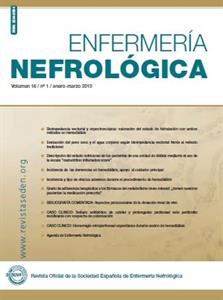Main Article Content
Abstract
Spontaneous retroperitoneal haemorrhage (SRH) includes any extravasation of blood into the retroperitoneal space without prior external trauma, endourological or endovascular manipulation. It has multiple aetiologies, highlighting the rupture of an abdominal aortic aneurysm as the most frequent cause in adults(1). Greater frequency of haemorrhages has been observed in patients with anticoagulation therapy and in patients undergoing long term haemodialysis (possibly due to the anticoagulation involved in their intradialytic treatment)(2), as is the case described below. It is a rare pathology in which, despite reaching a diagnosis in a relatively simple manner with image studies, determining the aetiology is a challenge and is the reason for multiple studies and invasive procedures, sometimes without being able to clarify the cause(3). Retroperitoneal haemorrhage of renal origin was first observed in 1700 by Bonet, being Wünderlich who defined it as "spontaneous apoplexy of the renal capsule" in 1856. Later, in 1910, Coenene designated it as "Wünderlich's syndrome"(4). The basic clinical picture is marked by the so-called Lenk triad: lumbo-abdominal pain of abrupt onset, palpable mass and hypovolaemic shock. Lumbar or abdominal pain is the predominant symptom. The most relevant analytical parameters are the drop in haemoglobin and haematocrit and leukocytosis(1,5).
Keywords
Article Details
Copyright (c) 2013 Raquel F. Galiano Roa, Joaquín Olmedo Bravo de Mansilla, Elisa Ropero Linán

This work is licensed under a Creative Commons Attribution-NonCommercial 4.0 International License.
Author copyright notice
© Authors grant the publisher the non-exclusive licence to publish the work and consent to its use and distribution under the Creative Commons Attribution - NonCommercial 4.0 International (CC BY-NC 4.0) licence. Read the licensing information and the legal text here. This must be expressly stated wherever necessary.
References
- Pode D, Caine M. Spontaneus retroperitoneal hem-orrhage. J Urol. 1992; 1147(2):311-318.
- González C, Penado S, Llata L, Valero C, Riancho JA. The clinical spectrum of retroperitoneal hema-toma in anticoagulated patients. Medicine 2003; 82: 257-262.
- RG Casey, CG Murphy, DP Hickey, TA Creagh. Wunderlich ́s síndrome, an unusual cause of the acute abdomen. Eur J Radiol 2006, Vol 57: 91-93.
- Peña Porta JM, Pernaute Lavilla R. Síndrome de Wünderlich en paciente en hemodiálsis con enfermedad quística renal adquirida. Aportación de un nuevo caso. Actas Urol Esp. 1999;23(1): 76-78.
- Ratcliffe PJ, Dunnill MS, Oliver DO. Clinical importance of acquired cystic disease of the kidney in patients undergoing diálisis.1983. Br. Med J.; 287: 1855-1858.
- Ivascu FA, Janczyk RJ, Bair HA, Bendick PJ, How-ells GA. Spontaneus retroperitoneal Hemorrhage. Am J Surg. 2005; 189(3): 345-347.
- Machuca Santacruz J, Julve Villalta E, Galacho Bech A, Pérez Rodríguez D, Quiñonero DíazA, Alonso Borrego JM. Hematoma retroperitoneal espontáneo: nuestra experiencia. Actas Urol Esp. 1992;189(3):345-347.
References
Pode D, Caine M. Spontaneus retroperitoneal hem-orrhage. J Urol. 1992; 1147(2):311-318.
González C, Penado S, Llata L, Valero C, Riancho JA. The clinical spectrum of retroperitoneal hema-toma in anticoagulated patients. Medicine 2003; 82: 257-262.
RG Casey, CG Murphy, DP Hickey, TA Creagh. Wunderlich ́s síndrome, an unusual cause of the acute abdomen. Eur J Radiol 2006, Vol 57: 91-93.
Peña Porta JM, Pernaute Lavilla R. Síndrome de Wünderlich en paciente en hemodiálsis con enfermedad quística renal adquirida. Aportación de un nuevo caso. Actas Urol Esp. 1999;23(1): 76-78.
Ratcliffe PJ, Dunnill MS, Oliver DO. Clinical importance of acquired cystic disease of the kidney in patients undergoing diálisis.1983. Br. Med J.; 287: 1855-1858.
Ivascu FA, Janczyk RJ, Bair HA, Bendick PJ, How-ells GA. Spontaneus retroperitoneal Hemorrhage. Am J Surg. 2005; 189(3): 345-347.
Machuca Santacruz J, Julve Villalta E, Galacho Bech A, Pérez Rodríguez D, Quiñonero DíazA, Alonso Borrego JM. Hematoma retroperitoneal espontáneo: nuestra experiencia. Actas Urol Esp. 1992;189(3):345-347.




